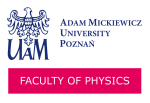Scholarship for PhD student – the project: Reconfigurable topological properties and frustrated ground states in magnonics
We are looking for the graduate student willing to start the PhD studies and to make a research in the field of magnonics in the framework of the National Science Center-Poland project:
“New platform for study wave phenomenon – reconfigurable topological properties and frustrated ground states in magnonics”,
coordinated by prof. Maciej Krawczyk in Institute of Spintronics and Quantum Information, in Faculty of Physics of Adam Mickiewicz University.
Project NCN OPUS no. UMO-2020/37/B/ST3/03936.
Scholarship
The doctoral student receives a scholarship of 5,000 PLN for the 36 months of the project realization. The amount of 11.26% will be subtracted from the scholarship for the obligatory national health insurance system (ZUS).
PhD studies
The competition is addressed to people who plan to start education at the Doctoral School at the University of Adam Mickiewicz in Poznań in academic year 2021/2022.
Recruitment
Schedule of the Doctoral School enrollment procedure:
- Registration in the Candidate Online Registration system (IRK): 1 July – 31 August, 2021, https://usosirk.amu.edu.pl/en-gb/offer/SD-2021/programme/SD-NFiz-G6/?from=field:DS010605N
- Required documents: see https://usosirk.amu.edu.pl/en-gb/offer/SD-2021/programme/SD-NFiz-G6/?from=field:DS010605N
- Submission of documents deadline: August 31, 2021
- Selection procedure: 6-10 September, 2021
- Announcement of the list of admitted candidates: 15 September, 2021
Scope of work in the frame work of the project
The PhD student will be responsible for patterning of the samples and extensive Brillouin light scattering (BLS) measurements, in particular measurements of the dispersion relation and detection of the spin wave intensity with micro-BLS in the fabricated samples. He/she will look for confined modes and propagating spin waves formed in the patterned samples, test usability of the pattern as an effective source of the spin waves, and design the pattern allowing for existence of the edge localized spin waves.
The research will be conducted in the active, international team. The scientific results will be published in high-quality international journals and disseminated through conference presentations. The young researchers involved in the program will receive extensive training in research and exposure to international collaboration, and culture through international visits.
For more details please contact prof. Maciej Krawczyk: krawczyk@amu.edu.pl
Required professional qualifications
The following qualifications and skills are required from the recruited PhD student:
- master degree in physics, material science, or in a similar scientific discipline;
- experimental background in solid-state physics, in particular physics of magnetism;
- knowledge of English.
Description of the project
We observe growing demand for mobile devices with wireless communication, which form a domain of the Internet of Things. This requires small and energetically efficient devices for signal processing, at increased frequencies and transfer rates exceeding possibilities of current CMOS based processors. There are various approaches considered to go beyond-CMOS, one of them involves magnonics, the emerging research and technology field focused on study of spin waves (SWs) which can transfer a spin for large distance without charge transfer, what minimizes the energy cost of the logic operations. Magnonic devices are easily reconfigurable and favorable for active control, difficult to achieve for other devices from photonics or electronics. Therefore, the magnonic systems can fill the gap between ultra-fast photonic and extremely miniaturized electronic systems, to design energetically efficient devices, miniaturized down to 100 nm and operating at relatively high frequencies in the range from few to tens of GHz.
Various types of interactions present in ferromagnetic films offer plethora of stable magnetization textures, including domain walls, vortexes and skyrmions. Additionally, the pattern in nanoscale introduce confinement and edge effects which further affect magnetic energy of the system and influence magnetization. Both types of systems have been investigated for many years with recent interest found in structures possessing discrete translational symmetry, like stripe domains, skyrmion lattices, magnonic crystals (MCs). However, synergy of the complex magnetization textures and the periodic pattern has not yet been illuminated, in particular with regard of SW properties and their topological properties. In this context, thin films with perpendicular magnetic anisotropy (PMA) are promising to become a playground with enormous number of realizations and interactions controlled in a wide range.
The main objective of the project is to define the MC based on thin PMA multilayers with an array of antidots possessing multiple magnetization states in the rims around antidots, suitable for formation of the confined and propagating SWs with nontrivial topological properties. With this universal platform we aim to demonstrate numerically and validate experimentally three breakthrough ideas providing new physics in magnonics and wave phenomena in general, and opening the rout for applications.

